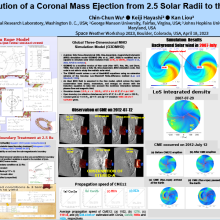Evolution of a coronal mass ejection from 2.5 solar radii to the Earth and beyond
Chin-Chun
Wu
Naval Research laboratory, Washington, DC, USA
Poster
Currently, there are two general approaches in magnetohydrodynamic (MHD) simulations of the global solar wind (with or without a coronal mass ejection, CME) in the heliosphere: (1) initiating a coronal model from the surface of Sun and merging the model result with a solar wind model at ~0.1 AU and (2) initiating the solar wind MHD model at ~0.1 AU with empirical and theoretical boundary conditions. The first approach can be cumbersome and impractical in space weather operation, whereas the second approach does not provide information about the CME and its driven shock within 0.1 AU (e.g., first ~4 hours, assuming Vcme = 1000 km/s). Here, we present a new modeling capability aiming for space weather. The model propagates a flux-roped coronal mass ejection from the source surface (2.5 Rs) to ~1 AU in a single model. This model is based on our G3DMHD solar wind model with three improvements: (1) extending the inner boundary from 18 Rs to 2.5 Rs, (2) adding the characteristic-based boundary treatment (Nakagawa et al., 1987; Wu and Wang, 1987) at the inner boundary to improve the model stability, and (3) injecting a self-contained magnetic flux-rope model (Chen, 1996) into the system at 2.5 Rs. We will demonstrate this new capability by simulating background solar wind in July 2007, and the CME event on July 12, 2012. Detailed results will be presented and compared with observation obtained at 1 AU.

Poster PDF
Poster category
Solar and Interplanetary Research and Applications
Meeting homepage